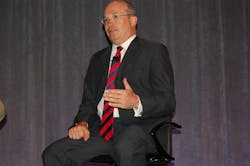DALLAS, TX. The trends are looking good for the trucking industry for the next two years despite productivity losses engendered by hours of service (HOS) reform, the driver shortage, and especially mandated imposition of electronic onboard recorders (EOBRs) now usually called electronic logging devices (ELDs).
That’s the analysis provided by Donald Broughton, managing director, senior research analyst and chief market strategist for Avondale Partners, here at the 2014 Commercial Vehicle Outlook Conference.
“I’ve got a relatively optimistic outlook for where the trucking industry is right now,” he said. “Though we remain in a slow- to no-growth economy, the exception is fracking, which continues to drive the first industrial-led economic recovery since the early 1960s. That’s why most economic analysts remain confused; we’ve never seen what an industrial-led recovery looks like.”
Broughton said the huge understated energy boom being driven by fracking in the U.S. – where drilling technology now extracts 5 to 6 times more oil compared to just 4 years ago – is being felt acutely in the freight market. He pointed out, for example, that while rail carload volumes were up 6% in 2013, petroleum shipments from fracking activity soared 24.7%.
“Fracking is ever and ever more successful, and modes that haul industrial-heavy goods like rail and trucking will keep benefiting from that,” he noted. “Every mode is experiencing some level of tonnage growth and every mode is struggling with capacity issues.”
The big trends Broughton believes will impact trucking area continued shift of consumer goods purchasing from retail stories to the online e-commerce world, increased movement of freight from over-the-road (OTR) trucks to intermodal, more consolidating within trucking’s ranks, and continued difficulty finding drivers.
The tight capacity environment especially in the TL sector should result in rate increases running from 4% to over 6% during the next two years as freight demand keeps rising, he said. Broughton noted that truck tonnage went up 5.8% overall in 2013, though loads were up only 2% due to the increasing weight of shipments being driven by the aforementioned growth in industrial and not consumer activity.
He added that EOBRs are exacerbating the truck capacity situation by cutting productivity by some 3% overall. Yet Broughton also expects two-thirds of commercial trucks will be equipped with EOBRs by the first quarter of next year.
“Regulations continue to shrink capacity,” he said. “I talked to many involved in trucking failures over the last 12 to 18 months and found they all had one thing in common – they’d been forced to adopt EOBRs.”
Broughton explained that typically then results in an 8% to 10% reduction in miles, meaning drivers watch their pay decline 10% to 15% in some cases. Many would then quit, leaving 5% to 15% of the fleet sitting idle. “Next thing you know they [the carriers] had to raise driver pay to account for the decline in miles, resulting in costs starting to spiral up, leading to their end,” he pointed out.
Normally a drop in tonnage accompanied by an increase in diesel fuel prices is what triggers a rash of trucking failures, Broughton said, but not this time. “Demand is up and diesel prices are actually flat to down,” he noted. “So what you have here are failures being driven by regulation.”
About the Author
Sean Kilcarr
Editor in Chief
Sean Kilcarr is a former longtime FleetOwner senior editor who wrote for the publication from 2000 to 2018. He served as editor-in-chief from 2017 to 2018.
